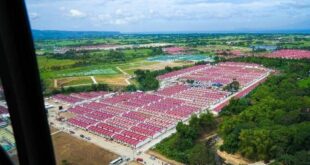The new Senate building now glistens as it stands out from among the mundane buildings located on Chino Roces Avenue extension in Taguig, Manila.

The P8.9-billion structure situated in Bonifacio Global City, Taguig City is almost finished, and is going to be ready for occupancy in January 2025.
Senate leaders would have wanted to make the official move-in to the new building to coincide with the third State of the Nation Address (SONA) of President Marcos this July 2024, but Senate President Juan Miguel “Migz” Zubiri dampened his colleagues’ high spirits saying they have to postpone it to a later date.
The move would have to be made in January 2025, and the Senate leader underscored that it would be his honor to lead the 24-man Senate to its seventh home since holding its first session in Oct. 16, 1916.
Sen. Maria Lourdes Nancy Binay, chairperson of the Senate Committee on Accounts, said it was a consensus among senators to move into the new Senate building in January 2025, instead of their earlier plan to transfer by July 2024 or this year.
According to Binay, the initial target schedule for the opening of the new Senate building was in 2021 or before the May 2022 elections. But due to the Covid-19 pandemic, construction of the new Senate building was delayed.
“Ang goal pa din is by July 2024; kahit papaano unti-unti na nakakalipat ang Senado (the goal is still by July 2024; the Senate will transfer little by little to the new building),” Binay said.
Senate Majority Leader Joel Villanueva, on the other hand, said the new Senate building was able to obtain a four-start rating certification in its first evaluation of BERDE Green building.
The rating is given by the Philippine Green Building Council—a non-stock, non-profit organization that promotes the sharing of knowledge on green practices to the property industry.
Villanueva also said the Senate has been able to ensure that its new building is on track in its goal of creating something that is meaningful of value and as a structure that houses the people’s aspirations and points away from the challenges of a changed environment.
“During its inception stage, we sought to build a green building that addressed the need for infrastructure that has minimal impact on our already burgeoning environment,” Villanueva said.
The Majority leader further said the Senate is targeting for a five-star rating in the next evaluation.
The Senate headquarters used to be at the neoclassical Old Legislative Building in Manila until May 1997, with the members and their staff occupying the upper floors.
The Old Legislative building was home to the bicameral Congress from 1926 to 1972.
Searching for home
But prior to this, the Senate has moved its home many times. According to the Official Gazette, the first home of the Upper House was at the Goldenberg Mansion. The first Philippine Senate session was held here on Oct. 16, 1916.
From here, the Senate moved to Intendencia and stayed here from 1916 to 1926. The Jones Law paved the way for the then newly-formed Philippine Senate to look for a new home. The building was then taken over by the Bureau of Customs (BoC) in 1926, and the Senate moved to a new location known to be the Legislative Building.
The said Legislative Building then housed both members of the Senate of the Philippines and the House of Representatives with the members of the House occupying the lower portion, while the Senate members occupying the upper level of the edifice. Thus the term: “Lower House” and “Upper House.”
It was here that then President Manuel L. Quezon delivered his last SONA before the start of the Japanese Occupation.
After the liberation of the Philippines from the Japanese in March 1945, the Legislative building lay in ruins along with the rest of Manila. The restored bicameral Congress moved to a school house in Lepanto Street which eventually served as a temporary Congress building for both the Senate and House.
Photo records suggest that some of the Senate’s sessions were conducted at the Manila City Hall’s session hall sometime in 1947 to 1948, even though the building itself was peppered with bullet holes from the Battle of Manila.
After a successful reconstruction efforts, lawmakers from both chambers then returned to the Legislative Building. The hall continued to serve the Senate from 1949 to Sept. 22, 1972.
When then President Ferdinand Marcos Sr. placed the entire country under martial law in Sept. 23, 1972, Congress was abolished; the Legislative building was closed down and was reinscribed as the “Executive House.”
The Legislative Building, then, became a “mixed use” building with some government agencies holding offices in some parts of the building. It now houses the National Museum of the Philippines, which became the sole occupant of the building.
In May 1997, the Senate moved to the GSIS building in Pasay City and has since held public plenary sessions, committee hearings and other legislative deliberations here.
Talks of the Philippine Senate moving to a permanent structure started since then, but it was only in 2017 that the proposal gained momentum with Sen. Sherwin Gatchalian filing Senate Resolution No. 293, creating an ad hoc committee that will conduct a feasibility study for the construction of a permanent edifice.
The Senate selected Fort Bonifacio in Taguig as the site of the new Senate building. Under then Sen. Panfilo “Ping” Lacson’s chairmanship of the accounts panel, the Senate was able to finalize the acquisition papers for the lot with the Bases Conversion and Development Authority (BCDA) at P500,000 per square meter.
In February 2018, the Philippine Senate launched a design competition for the new Senate building. Five companies were shortlisted, namely: AECOM, Aidea, Henning Larsen Architects, Leeser Architecture, and Pelli Clarke Pelli Architects. AECOM won the competition.
The Department of Public Works and Highways (DPWH), which implemented the project, awarded the contract to Hilmarc Construction Corp. The topping-off ceremony was held in July 20, 2023.
In September 2021, former President Rodrigo Duterte had tried to question the credibility of Hilmarc winning the bid, but this eventually fizzled out.
Former Senate President Vicente Sotto III led the symbolic lowering of the time capsule at the new Senate building. Also in photo are Senators Panfilo “Ping” Lacson and Maria Lourdes Nancy Binay.
— Hannah Torregoza
*****
Credit belongs to: www.mb.com.ph
 Atin Ito First Filipino Community Newspaper in Ontario
Atin Ito First Filipino Community Newspaper in Ontario






